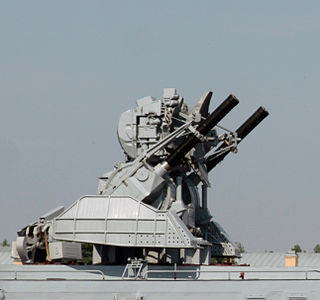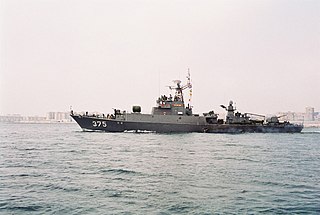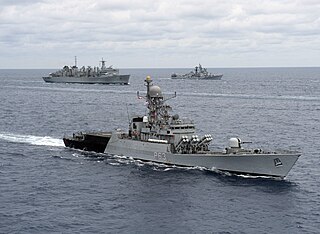It has been requested that the title of this article be changed to Sovremenny-class destroyer . Please see the relevant discussion on the discussion page. Do not move the page until the discussion has reached consensus for the change and is closed. |
This article needs additional citations for verification .(January 2013) (Learn how and when to remove this template message) |
 Sovremennyy-class destroyer Bezuprechnyy | |
| Class overview | |
|---|---|
| Name: | Sovremennyy class |
| Builders: | Severnaya Verf (Zhdanov Shipyard) |
| Operators: | |
| Preceded by: |
|
| Succeeded by: |
|
| In commission: | 1980 |
| Completed: | 21 |
| Active: | 3 active, 1 ongoing modernization and 2 in reserve in Russia; 4 active in China |
| Retired: | 10 |
| General characteristics | |
| Type: | Anti-aircraft and anti-ship guided missile destroyer |
| Displacement: | 6,600 tons standard, 8,480 tons full load |
| Length: | 156 m (511 ft 10 in) |
| Beam: | 17.3 m (56 ft 9 in) |
| Draught: | 6.5 m (21 ft 4 in) |
| Propulsion: | 2 shaft steam turbines, 4 boilers, 75,000 kW (100,000 hp), 2 fixed propellers, 2 turbo generators,and 2 diesel generators |
| Speed: | 32.7 knots (60.6 km/h; 37.6 mph) |
| Range: | 14,000 nmi (26,000 km; 16,000 mi) at 14 knots (26 km/h; 16 mph) |
| Complement: | 350 |
| Sensors and processing systems: |
|
| Electronic warfare & decoys: | 2 PK-2 decoy dispensers (200 rockets) |
| Armament: |
|
| Aircraft carried: | 1× Ka-27 'Helix' |
The Sovremennyy-class destroyer is the principal anti-surface warship of the Russian Navy ("Sovremennyy" translates like "Modern"). The Soviet designation for the class was Project 956 Sarych (Buzzard).

A warship or combatant ship is a naval ship that is built and primarily intended for naval warfare. Usually they belong to the armed forces of a state. As well as being armed, warships are designed to withstand damage and are usually faster and more manoeuvrable than merchant ships. Unlike a merchant ship, which carries cargo, a warship typically carries only weapons, ammunition and supplies for its crew. Warships usually belong to a navy, though they have also been operated by individuals, cooperatives and corporations.

The Russian Navy is the naval arm of the Russian Armed Forces. It has existed in various forms since 1696, the present iteration of which was formed in January 1992 when it succeeded the Navy of the Commonwealth of Independent States.
Contents
- History
- Design
- Command and control
- Missiles
- Guns
- Anti submarine systems
- Helicopter
- Countermeasures
- Sensors
- Propulsion
- PLAN variants
- Ships
- See also
- References
- External links
The primary role of this guided missile destroyer is to attack enemy warships while also providing sea and air defense for warships and transports under escort. It complements the Udaloy-class destroyers in anti-submarine operations.

A guided-missile destroyer is a destroyer designed to launch guided missiles. Many are also equipped to carry out anti-submarine, anti-air, and anti-surface operations. The NATO standard designation for these vessels is DDG. Nations vary in their use of destroyer D designation in their hull pennant numbering, either prefixing or dropping it altogether. The U.S. Navy has adopted the classification DDG in the American hull classification system.

The Udaloy-class are a series of anti-submarine destroyers built for the Soviet Navy, eight of which are currently in service with the Russian Navy. The Russian designation is Project 1155 Fregat. Twelve ships were built between 1980 and 1991, while the thirteenth ship built to a modified design as the Udaloy II class followed in 1999. They complement the Sovremennyy-class destroyer in anti-aircraft warfare and anti-surface warfare operations.

Anti-submarine warfare is a branch of underwater warfare that uses surface warships, aircraft, or other submarines to find, track, and deter, damage, or destroy enemy submarines.
































